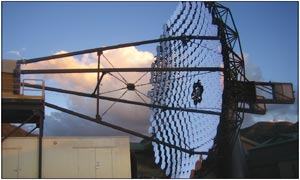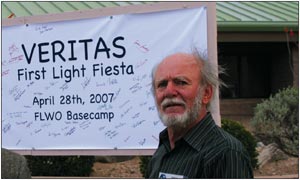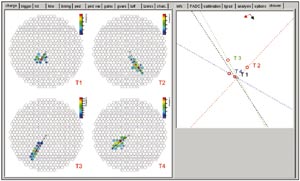David Hanna looks at the VHE gamma-ray telescope array in Arizona.

For three days in late April, collaboration members gathered with invited guests and the general public to celebrate the completion of the Very Energetic Radiation Imaging Telescope Array System (VERITAS). Located near Mount Hopkins in southern Arizona, the new array joins HESS in Namibia, MAGIC in the Canary Islands and CANGAROO-III in Australia in the exploration of the gamma-ray skies at energies from 100 GeV to beyond 10 TeV. The First Light Fiesta included a one-day scientific symposium, a well-attended public lecture, public tours of the new detector and a formal inauguration ceremony followed by an outdoor banquet.
Cherenkov astronomy
VERITAS is the latest stage in the evolution of very-high-energy (VHE) gamma-ray astronomy, a field where many aspects are closer to particle physics than to traditional astronomy. The basic idea is to use the Earth’s atmosphere as the “front end” of the detector, much like a calorimeter in a collider experiment. At high energies, gamma rays initiate extensive air showers in the upper atmosphere, and relativistic particles in these showers radiate Cherenkov photons that penetrate to ground level. An imaging detector located anywhere in the light pool can use the size and pattern of hits in its camera to reconstruct the energy and direction of the shower and, by extension, the primary particle that spawned it. This is the principle of the imaging atmospheric Cherenkov telescope (IACT). The effective area of the detector is the size of the light pool, which is of the order of 100,000 m2.
The main background comes from charged cosmic rays, energetic protons and light nuclei, which typically outnumber gamma rays by a factor of more than 1000. These can be rejected by using differences in the morphology of gamma-initiated and hadron-initiated showers that are manifest in the image at the camera’s focal plane. Indeed, it is the cosmic-ray rejection power afforded by multiple views of the shower that has motivated the construction of the modern arrays of IACTs.
The basic technique traces back to the early 1950s, when pioneering measurements were made using instruments built with war-surplus searchlight mirrors. Following a long learning curve, the Whipple collaboration announced the detection of the first VHE source, the Crab Nebula, in 1989. The detector used a 10 m mirror and a pixellated camera, allowing the use of imaging to improve the signal-to-noise ratio. The Crab Nebula, a strong and steady source with a spectrum extending to beyond 50 TeV, has since become the “standard candle” in the field.
During the 1990s, more imaging Cherenkov detectors were built as interest in high-energy gamma-ray astronomy intensified around the world. This was partly because the Compton Gamma-Ray Observatory had been placed in orbit and was discovering dozens of sources at giga-electron-volt energies. Notable among the second-generation detectors was HEGRA, an array of five small telescopes constructed on La Palma in the Canary Islands, which demonstrated the power of “stereo” observations.

Towards the end of the decade, plans began for a third generation of detectors, exploiting the advantages of arrays from large reflectors viewed by fine-grained cameras. The VERITAS collaboration, with members from institutes in the US, Canada, Ireland and the UK, combined the original Whipple group with new collaborators from gamma-ray, cosmic-ray and particle-physics research. Together, they proposed a detector for southern Arizona, built a prototype at the Whipple Base Camp in the summer of 2003 and obtained funding for a four-telescope array later that year.
The final array consists of four IACTs, each of which uses a 12 m-diameter mirror to focus light onto a camera comprising 499 close-packed 29 mm photomultiplier tubes (PMTs). Each mirror is tessellated, with 350 identical hexagonal facets mounted on a steel frame. PMT pulses are digitized by custom-built 500 MS/s flash analogue-to-digital converters and readout is initiated by a three-level trigger, which starts with discriminators on each channel, proceeds to pattern recognition in each camera and finally makes an array-based decision.
First and future light
Although the First Light ceremony was held in April, VERITAS has been making observations in a variety of configurations since 2003, as each telescope has been commissioned. The first stereo observations were made in 2006 when the second telescope was completed and came in time to detect the blazar Mrk 421 in an active state. More importantly, VERITAS detected a similar source, Mrk 501, during a quiescent phase with a flux of only 0.8 gammas per minute. Such a measurement had not been possible with only one VERITAS telescope. During the 2006–2007 observing season, with two and then three telescopes, VERITAS has measured phase-dependent variable VHE flux from the micro-quasar candidate LSI +61303, and has detected VHE gamma rays from the giant radiogalaxy M87, as well as the distant active galaxy 1ES 1218+30.4. Analysis of these and other topics are well in hand for the summer conferences, and the collaboration presented its preliminary findings at the First Light symposium.

The fourth telescope was completed in early 2007 and the array is now the most sensitive gamma-ray telescope in the northern hemisphere. It is able to make a 5 σ detection of a source with a flux level a tenth that of the Crab Nebula in under an hour (the original Whipple detection of the Crab Nebula required more than 50 hours). In the energy range from 100 GeV to 30 TeV, VERITAS’s effective area rises from around 30,000m2 to well over 100,000 m2 and its energy resolution is 10–20%. Single-event angular resolution is better than 0.14°, and sources with reasonable flux will be located to better than 100 arc-seconds. The 3.5° field of view, with off-axis acceptance above 65% out to 1° from the centre, will allow sky surveys as well as the mapping of extended sources.
In contrast to collider experiments, where data on different physics topics are accumulated simultaneously with different triggers, telescopes are pointed instruments and a scheduling committee decides where they point. For the first two years of observations, VERITAS will spend half of the available hours on four Key Science Projects (KSPs). The remaining time will be given over to observations proposed by groups within the collaboration.
One KSP is a survey of part of the Milky Way visible from the northern hemisphere, which will search for new sources with fluxes greater than about 5% of the Crab Nebula. Another KSP is an indirect search for dark matter. WIMPs could cluster in gravitational wells such as nearby dwarf galaxies or globular clusters and then annihilate, producing a continuum of gamma rays that May be strong enough to be seen by VERITAS. Although less direct than a search for supersymmetric particles at an accelerator, the gamma-ray technique targets a larger range of candidate masses.

Another KSP concerns galactic sources such as pulsar-wind nebulae and supernova remnants (SNRs), while yet another deals with extragalactic sources known as active galactic nuclei (AGNs). SNRs are interesting because they could possibly be the source of most galactic cosmic rays. With the new-generation detectors, their morphologies can be resolved and this will aid in the understanding of particle acceleration models. Gamma rays from AGNs are thought to originate in their relativistic plasma jets, which are powered by accretion of host-galaxy material by a supermassive black hole. These sources are notoriously time-variable, so the plan is to conduct multi-wavelength campaigns using contemporaneous X-ray, optical and radio observations to uncover the physics processes at work in these high-energy objects.
All observations will be pre-empted when a gamma-ray burst (GRB) occurs in a visible part of the sky and VERITAS turns its attention to it. The telescope is connected to a network that relays GRB detections from spacecraft and the array can slew to any part of the sky at a rate of 1°/s.
Later this year the Gamma-ray Large Area Space Telescope (GLAST) should join the hunt for high-energy gamma rays from a vantage point in orbit around the Earth. With its wide field of view and sensitivity in energy from 20 MeV to more than 100 GeV, it will provide complementary data and increase the scientific reach of the new ground-based observatories. After many years of design, construction and commissioning, the VERITAS collaboration anticipates a rewarding future.








